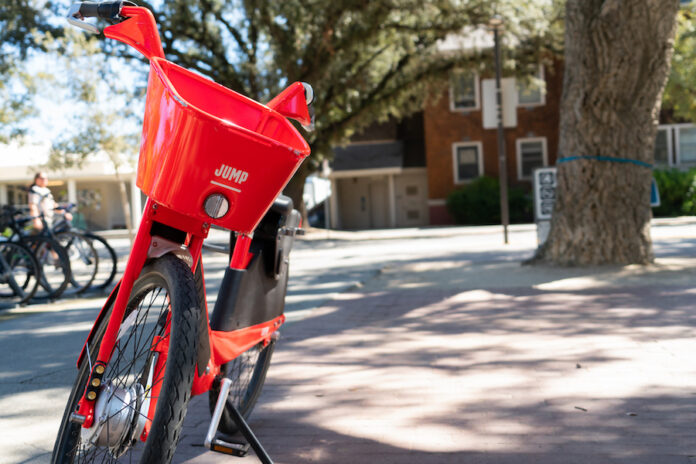Students, faculty and members of the UC Davis community ride electric JUMP bikes around campus and the city of Davis
Bright red with a sturdy seat and practical basket, these electric bikes can be seen zooming past the rainbow of regular bikes owned by students. JUMP bikes have made their mark on the UC Davis campus during the 2018-19 school year.
The Uber-owned company launched its bicycle sharing program in Sacramento, West Sacramento and Davis in June 2018, according to the transportation demand manager Ramon Zavala. The program started with only 15 bikes in Davis, but now, there can be anywhere from 130-150 bikes in the city. The initial bicycle sharing program includes 900 bikes, and the vast majority are in Sacramento in the downtown area.
“JUMP creates on-demand electric bikes and scooters that allow you to go farther, get there faster and have more fun,” according to the JUMP website.
In Davis, a majority of the use for JUMP bikes includes small trips and commuting, as well as getting around campus itself, according to Zavala.
“Everyone knew that Davis was ripe for bikeshare,” Zavala said. “We would rather have people ride an automatically maintained JUMP bike than their own rust bucket.”
According to Zavala, JUMP bikes are a good alternative for people instead of leaving a bike on campus. Many bikes that are left on campus rot, get parted, partially stolen or end up being impounded by the UC Davis Transportation Services (TAPS).
“Going from the bus to your office or to your first class, that’s perfect for JUMP,” Zavala said. “My team thought, ‘Wouldn’t it be great to just have a lot of bikes on campus for people to use and they all just pay more into the system?’”
First-year undeclared social sciences major Kylie Crisostomo-Rickman said that she has used JUMP bikes five or six times this year.
“I use it mostly when I lose my bike key or my bike isn’t working for some reason and I have to get to class,” Crisostomo-Rickman said. “I hate walking and the JUMP bike is a nice alternative, especially because it’s pretty cheap.”
To use a JUMP bike, an individual needs to use either the JUMP or Uber app to create a regular account and put raw cash in it, or sign up for a membership. To just use the bike regularly, an individual can pay as they go, $1 per 15 minutes and then $0.07 per minute after that.
Students who create an account can receive a discount, where they pay $30 for a 12-month membership. You get an hour a day of use included in the membership and any minute you go after that is $0.07/1 minute, according to Zavala.
Other than the low cost, a benefit of JUMP bikes is their electric quality. The bikes are pedal-assist, which means the bike multiplies the power a rider puts into it. Zavala said that riding a JUMP bike is as simple as riding any other bike.
“A lot of people find it very easy to go up hills, carry more cargo, go longer distances, and you can get to work in work clothes and barely break a sweat,” Zavala said.
Riding JUMP bikes is good exercise, since riders still burn calories, but not as much as riding a regular bike. Also, JUMP bikes are unlike other electric bikes where riders can stop pedaling and keep moving, since riders still need to pedal to move.
“It’s just like a little boost,” Crisostomo-Rickman said. “Since it’s in the pedaling, if you pedal faster, there’s more power, so it’s not super fast and not fully electric, but it’s still a little bit faster than a regular bike.”
Even though there are many benefits to the bicycle sharing system, an issue Zavala has found involves parking. According to him, the best places to park the bikes are on a bike rack or near where other bikes are parked.
“There are some bikes that do not have docks, like Lime Bikes, so it creates the expectation that you can leave them anywhere,” Zavala said. “JUMP bikes have their own locking system, but because they are a part of this culture, people will just leave them wherever. And that is sometimes fine if they are left within bike parking area and there are no free bike racks.”
JUMP bikes have their own locking system, and due to the culture of dockless communal vehicles, people have been leaving them in inappropriate places, which can result in individuals receiving fines.
“It becomes an issue when you leave it on a sidewalk, preventing people from walking through, or on roads or handrails,” Zavala said.
Due to the overall benefits they bring to campus, in the future, Zavala hopes to see more JUMP bikes on campus. He thinks it is a better solution financially, personally and logistically than leaving an extra bike on campus.
“I have an explicit hope that people won’t feel the need to leave a junk bike near a parking lot or near one of the bus depots because there will be sufficient JUMP bikes to use once they park their car or get off the bus,” Zavala said.
Written by: Margo Rosenbaum — features@theaggie.org




